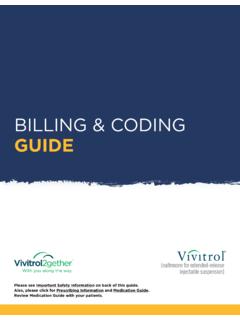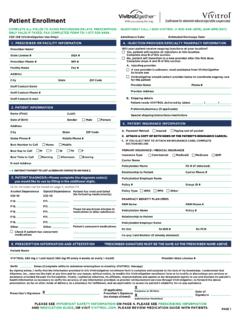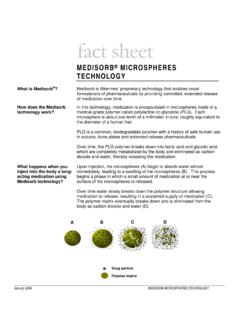Transcription of With lessons from Advancing Recovery - NIATx
1 TM. getting started with medication - assisted treatment with lessons from Advancing Recovery TM. getting started with medication - assisted treatment getting started with medication - assisted treatment is a publication of NIATx made possible with funding from The Robert Wood Johnson Foundation. Editor: Maureen Fitzgerald Authors: Lisa Clark, RN, MSN. Clark Consulting Delray Beach, FL. Eric Haram, LADC. Director of Outpatient Behavioral Health Mid Coast Hospital Brunswick, ME. Kim Johnson, MS Ed, MBA. Co-Deputy Director, NIATx Center for Health Enhancement Systems Studies University of Wisconsin-Madison Todd Molfenter, PhD. Co-Deputy Director, NIATx Center for Health Enhancement Systems Studies University of Wisconsin-Madison Contributors Advancing Recovery Baltimore Advancing Recovery Maine Bonnie Campbell Linda Frazier Director of Policy and Planning Baltimore Substance Abuse Systems Advancing Recovery Missouri Nora Bock Advancing Recovery Colorado Director of Community Programs Bill Wendt Terry Morris CEO/General Counsel Former Clinical Director Erik Stone Mark Stringer Signal Behavioral Health Network Director Missouri Department of Mental Health Ron Gowins, BS, CACIII Division of Alcohol and Drug Abuse Substance Use Disorders Services Team Leader Advancing Recovery Texas Denver Health, Outpatient Behavioral Doug Denton, Executive Director Health Services Diana Burns Homeward Bound Advancing Recovery Florida Dallas, Texas Stephenie Colston Director Janet Anselmo-Henson Mental Health/Substance Abuse Services Manager.
2 Substance Abuse Services Sheila Barbee Dallas County Juvenile Probation Performance Management & Department Improvement Director Substance Abuse Program Office Advancing Recovery West Virginia Florida Dept. of Children & Families Bob Hansen, Executive Director Genise Lalos, MA, LSW, CCAC-S. Rhonda Bohs, Director of Addictions Services Vice-President, Research Prestera Center for Mental Health Spectrum Programs & Miami Behavioral Services, Inc. Health Center Huntington, West Virginia Kay M. Doughty, MA, CAP, CPP Editorial Review: VP, Family and Community Services Mark Publicker, , FASAM. Operation PAR, Inc. Mike Boyle Pinellas Park, Florida Former CEO, Fayette Companies Peoria, Illinois Gloria Hanania, LMHC CAP Advancing Recovery Coach/Consultant Senior Director of treatment Services River Region Human Services, Inc. Copyright 2010, University of Wisconsin Madison Permission is granted for this material to be shared for noncommercial, Jacksonville, Florida educational purposes, provided that this notice appears on reproduced materials and copies are not altered.
3 Contents The business case for MAT.. 3. Maine ARC model.. 4. Securing buy-in from your staff and board.. 5. Building staff buy-in .. 6. Changing staff beliefs through education .. 7. Overcoming community resistance.. 9. Building support for MAT through local media.. 9. Advocating MAT for adolescents.. 12. Building statewide support .. 14. Paying for MAT .. 15. Building relationships with drug companies.. 17. Using a partnership of state and providers .. 19. Finding prescribers.. 21. Building support from many different stakeholders.. 23. Making good use of physician time.. 25. Licensing and credentialing .. 26. State licensing rules.. 28. Screening and assessing patients.. 29. Inducting patients: Maine ARC model.. 30. Using community resources to help patients: another model.. 33. Combining medication and therapy .. 35. Fayette Companies model .. 35. Using customer input to focus efforts .. 37. Sustaining your MAT program.
4 40. Duration of medication - assisted treatment .. 40. Maintaining Recovery and access to medication .. 40. Engaging the Recovery community.. 40. Celebrating your MAT program .. 41. Appendix .. 42. The medications.. 43. MAT and pregnant women .. 47. Sample forms .. 48. Online resources and reading.. 53. Index of case studies .. 56. Introduction medication - assisted treatment (MAT) is the use of medications, combined with counseling, to treat substance use disorders. Research has proven the effectiveness of MAT and addiction treatment experts endorse it, but a variety of barriers have prevented the widespread use of MAT. These include a lack of financing for medication , insufficient organizational infrastructure to deliver medication , state and county funding and regulatory obstacles, physician training and certification, staff and client resistance, and community attitudes. Advancing Recovery : State/Provider Partnerships for Quality Addiction Care (AR).
5 Was a national initiative funded by the Robert Wood Johnson Foundation. The five- year (2005 2010) project was co-directed by the Network for the Improvement of Addiction treatment ( NIATx ) at the University of Wisconsin Madison and the treatment Research Institute (TRI) in Philadelphia. The goal of the grant was to promote the use of evidence-based practices such as MAT through innovative partnerships between state agencies and treatment organizations. This toolkit shares lessons that emerged from the efforts of several of the grantees to establish MAT programs in their organizations. 1. The NIATx MAT Toolkit Introduction Elements of Successful Recovery Addiction medication Substance Abuse treatment Physical Health Medications Case Management Mental Health medication Wrap-around Services Aftercare and Peer Support 12-step Program and Sponsor Mental Health Evaluation Physical Health Assessment Counseling treatment Case Management Follow-up Source: Doug Denton, Executive Director, Homeward Bound, Dallas Texas The National Institute on Drug Abuse (NIDA) endorses medication in treating substance use disorders, and especially combining it with counseling and other behavioral therapies.
6 Medications that have emerged in recent decades have transformed lives. Ongoing research efforts are testing additional medications that show promise for treating alcohol and cocaine addiction. The National Quality Forum has developed consensus standards for addressing substance use illnesses. Four of the eleven standards focus on the use of medications. Specifically, they state that everyone receiving detoxification or treatment for opiate, alcohol, or nicotine dependency should be offered medications. Bridging the Gap Between Practice and Research: Forging Partnerships with Community-Based Drug and Alcohol treatment , a report issued by the Institute of Medicine in 1998, discusses the gap between what scientific research has found to be effective treatment for substance use disorders and the type of care delivered in substance-abuse treatment settings. Since then, NIDA and SAMHSA have been working to bridge the gap identified in the report.
7 2. 2010 NIATx and the University of Wisconsin Madison. All Rights Reserved. The business case for MAT. T he estimated expense to society of opioid addiction nears $20 billion annually, yet the cost of treating an individual addicted to opioids is only $4,000 per year. If every opioid-dependent person in the United States received treatment , $16 billion would be saved every year. National Drug Court Institute Practitioner Fact Sheet Methadone Maintenance and Other Pharmacotherapeutic Interventions in the treatment of Opioid Addiction. April 2002, Vol. lll, No. 1. In the business world, a business case justifies offering a new product or service by evaluating the potential costs, risks, and benefits. medication - assisted treatment not only improves client outcomes and transforms lives; it also can be more cost-effective than other forms of treatment . Advancing Recovery Florida implemented MAT with Vivitrol at three sites. This graph shows the dramatic drop in average drinking days after just one injection.
8 Number of Heavy Drinking Days per Month 30. 25. 20. 15. 10. 5. 0. 1 2 3 4 5 6. Month of Injection Number of Heavy Drinking Days per Month 3. The NIATx MAT Toolkit The business case for MAT. Case Study: Making the Business Case for MAT. Advancing Recovery Maine The Addiction Resource Center (ARC), part of Mid Coast Hospital in Brunswick, Maine, developed a strong business case for offering on-site buprenorphine services. In 2007, ARC took a snapshot of opioid-addicted clients entering treatment . In February, 20 clients diagnosed with opioid dependence completed screening and intake to enter treatment . Five of the 20 clients made their first appointment for treatment after their psychosocial assessment. Staff spent an average of two hours per client trying to find a prescriber for buprenorphine. A community prescriber accepted all five clients for buprenorphine induction. The remaining 15 clients were lost and did not attend any treatment sessions.
9 In short, only 25 percent of those who completed screening and intake were treated. The five clients who entered treatment required 20 hours of clinical assessment that month and 40 hours of phone and referral work. Basic revenue = $ 1, (20 assessments plus five initial Intensive Outpatient treatment sessions). Basic direct cost = $1, (60 hours at an average rate of $ ). Return on investment: $ treatment engagement outcome = 25%. In the first month that ARC implemented MAT with buprenorphine, 34 opioid dependent clients were screened. Twenty-nine of these 34 clients attended the first treatment session, representing an 85% assessment conversion rate. Bringing a buprenorphine prescriber in-house relieved clients' withdrawal and craving more rapidly, which helped them stay engaged in treatment and made the intervention more effective. Basic revenue = $ (34 assessments + 29 inductions + 29 IOP days). Basic direct cost = $ (34 counselor hrs + 29 MD hrs.)
10 Return on investment = $4, treatment engagement outcome= 85%. ARC found buprenorphine treatment was cost effective and it improved client outcomes. Says one staff member, Clients did not stay in treatment before we offered this service. We worked twice as hard for half the revenue and had worse outcomes. with MAT, you feel like you 4 have effective tools at your side.. 2010 NIATx and the University of Wisconsin Madison. All Rights Reserved. Securing buy-in from your board and staff While MAT has been shown to improve lives, families, and by extension, communities, treatment organizations face multiple barriers to implementing MAT, both internally and externally. The board of directors or other governing group for an organization may need to be convinced of the benefits of an MAT program. In West Virginia, Prestera Center's staff gave the board of directors outcome data from programs around the country that were showing remarkable results, along with personal Recovery stories from individuals who had tried and failed many times to sustain their Recovery from opiates with traditional therapies.





